Enhanced Mechanical Performance of GFRP Rebars Using Plasma-Treated Natural Fiber Powder Fillers
Abstract
1. Introduction
2. Experimental Program
2.1. Specimens and Materials
2.2. Plasma Surface Treatment
2.3. Fabrication of GFRP Rebars
2.4. Mechanical Testing
2.4.1. Tensile Strength Testing
2.4.2. Transverse Shear Strength Testing
2.4.3. Flexural Strength Testing
2.4.4. Pull-Out Bond Strength Testing
2.5. Morphology
2.6. Reaction Mechanism
2.7. Statistical Analyses
3. Results and Discussion
3.1. Tensile Properties
3.2. Flexural Properties
3.3. Shear Properties
3.4. Bond Strength with Concrete
3.5. Morphological Observations via SEM
3.6. FTIR Analysis
4. Conclusions
- Mechanical Performance: The incorporation of 5 wt.% untreated hemp (HU) and bamboo (BU) powders generally resulted in reduced tensile, flexural, and shear strengths due to poor interfacial bonding between the hydrophilic fillers and the hydrophobic epoxy matrix. In contrast, plasma-treated fillers (HT and BT) significantly enhanced mechanical properties, with HT achieving approximately 95% of the control’s tensile strength and showing notable improvement in transverse shear strength. These results highlight the effectiveness of plasma surface treatment in restoring and reinforcing mechanical performance.
- Bond Behavior with Concrete: Pull-out tests demonstrated that neither the filler type nor surface treatment significantly affected the bond strength between GFRP rebars and concrete. This indicates that external surface roughness and mechanical interlocking mechanisms, rather than internal resin chemistry, primarily govern bond performance at the rebar-concrete interface.
- Morphological Characteristics: SEM analysis revealed improved filler dispersion, reduced voids, and enhanced matrix wetting in the plasma-treated groups. Evidence of resin encapsulation and limited fiber pull-out in HT and BT rebars supports the observed improvements in mechanical integrity and stress transfer efficiency.
- Chemical Surface Modification: FTIR analysis confirmed the formation of polar functional groups (-OH, -COOH, C=O) on the surface of plasma-treated fillers. These chemical modifications enhanced the filler-matrix interfacial adhesion, promoting better mechanical interlocking and reducing microstructural defects. This finding aligns with previous studies on plasma-treated natural fibers such as flax, Arundo donax, and kapok.
Author Contributions
Funding
Data Availability Statement
Acknowledgments
Conflicts of Interest
References
- Nugraha, A.D.; Nuryanta, M.I.; Sean, L.; Budiman, K.; Kusni, M.; Muflikhun, M.A. Recent Progress on Natural Fibers Mixed with CFRP and GFRP: Properties, Characteristics, and Failure Behaviour. Polymers 2022, 14, 5138. [Google Scholar] [CrossRef]
- Zhang, W.; Yang, X.; Lin, J.; Lin, B.; Huang, Y. Experimental and numerical study on the torsional behavior of rectangular hollow reinforced concrete columns strengthened By CFRP. Structures 2024, 70, 107690. [Google Scholar] [CrossRef]
- Liu, J.L.; Pham, V.N.H.; Mencattelli, L.; Chew, E.; Chua, P.Y.; Shen, J.; Tian, K.; Zhi, J.; Jiang, D.; Tay, T.E.; et al. Improving the impact performance of natural fiber reinforced laminate through hybridization and layup design. Compos. Sci. Technol. 2024, 251, 110585. [Google Scholar] [CrossRef]
- Fiore, V.; Scalici, T.; Nicoletti, F.; Vitale, G.; Prestipino, M.; Valenza, A. A new eco-friendly chemical treatment of natural fibres: Effect of sodium bicarbonate on properties of sisal fibre and its epoxy composites. Compos. Part B Eng. 2016, 85, 150–160. [Google Scholar] [CrossRef]
- Naguib, H.M. Evaluation of filler activation for sustainable FRP composite by studying properties, mechanism, and stability. Sci. Rep. 2024, 14, 18256. [Google Scholar] [CrossRef] [PubMed]
- Nyssanbek, M.; Kuzina, N.; Kondrashchenko, V.; Azimov, A. Effects of plasma treatment on biodegradation of natural and synthetic fibers. npj Mater. Degrad. 2024, 8, 23. [Google Scholar] [CrossRef]
- John, M.J.; Thomas, S. Biofibres and biocomposites. Carbohydr. Polym. 2008, 71, 343–364. [Google Scholar] [CrossRef]
- Sun, D. Surface Modification of Natural Fibers Using Plasma Treatment. In Biodegradable Green Composites; John Wiley & Sons: Hoboken, NJ, USA, 2016; pp. 18–39. [Google Scholar]
- Dimic-Misic, K.; Bratislav, O.; Milorad, K.; Mirjana, K.; Quang, L.H.; Matea, K.; Monireh, I.; Gane, P. Production of Micro Nanofibrillated Cellulose from Prerefined Fiber via a Dry Dielectric Barrier Discharge (DBD) Oxygen Plasma-Treated Powder Precursor. J. Nat. Fibers 2024, 21, 2394146. [Google Scholar] [CrossRef]
- Saleem, M.; Naz, M.Y.; Shukrullah, S.; Shujah, M.A.; Ullah, S.; Al-Sehemi, A.G. Statistical optimization of open air dielectric barrier discharge plasma effect on self-cleaning activity of ultrasonically Cu2O/TiO2-coated cotton fabric. Appl. Phys. A 2021, 127, 776. [Google Scholar] [CrossRef]
- Rachtanapun, P.; Sawangrat, C.; Kanthiya, T.; Thipchai, P.; Kaewapai, K.; Suhr, J.; Worajittiphon, P.; Tanadchangsaeng, N.; Wattanachai, P.; Jantanasakulwong, K. Effect of Plasma Treatment on Bamboo Fiber-Reinforced Epoxy Composites. Polymers 2024, 16, 938. [Google Scholar] [CrossRef]
- Sawangrat, C.; Jantanasakulwong, K.; Suhr, J.; Kaewapai, K.; Kanthiya, T.; Thipchai, P.; Rachtanapun, P.; Wattanachai, P. Synergistic Effects of Dielectric Barrier Discharge Plasma Treatment on Hemp Fiber Surface Modification and Mechanical Properties of Hemp-Fiber-Reinforced Epoxy Composites. Appl. Sci. 2025, 15, 2818. [Google Scholar] [CrossRef]
- Yuan, X.; Jayaraman, K.; Bhattacharyya, D. Effects of plasma treatment in enhancing the performance of woodfibre-polypropylene composites. Compos. Part A Appl. Sci. Manuf. 2004, 35, 1363–1374. [Google Scholar] [CrossRef]
- Sinha, E.; Panigrahi, S. Effect of Plasma Treatment on Structure, Wettability of Jute Fiber and Flexural Strength of its Composite. J. Compos. Mater. 2009, 43, 1791–1802. [Google Scholar] [CrossRef]
- Morent, R.; De Geyter, N.; Verschuren, J.; De Clerck, K.; Kiekens, P.; Leys, C. Non-thermal plasma treatment of textiles. Surf. Coat. Technol. 2008, 202, 3427–3449. [Google Scholar] [CrossRef]
- Sever, K.; Erden, S.; Gülec, H.A.; Seki, Y.; Sarikanat, M. Oxygen plasma treatments of jute fibers in improving the mechanical properties of jute/HDPE composites. Mater. Chem. Phys. 2011, 129, 275–280. [Google Scholar] [CrossRef]
- Harsha Vardhan, D.; Ramesh, A.; Chandra Mohana Reddy, B. Effect of ceramic fillers on flexural strength of the GFRP composite material. Mater. Today Proc. 2021, 37, 1739–1742. [Google Scholar] [CrossRef]
- Sravanthi, K.; Mahesh, V.; Nageswara Rao, B. Influence of micro and nano carbon fillers on impact behavior of GFRP composite materials. Mater. Today Proc. 2021, 37, 1075–1078. [Google Scholar] [CrossRef]
- Sharma, M.; Sharma, R.; Chandra Sharma, S. A review on fibres and fillers on improving the mechanical behaviour of fibre reinforced polymer composites. Mater. Today Proc. 2021, 46, 6482–6489. [Google Scholar] [CrossRef]
- Jawaid, M.; Abdul Khalil, H.P.S. Cellulosic/synthetic fibre reinforced polymer hybrid composites: A review. Carbohydr. Polym. 2011, 86, 1–18. [Google Scholar] [CrossRef]
- Dhawan, V.; Singh, S.; Singh, I. Effect of natural fillers on mechanical properties of GFRP composites. J. Compos. 2013, 2013, 792620. [Google Scholar] [CrossRef]
- Kabir, M.M.; Mustak, R.; Hasan Sadik, M.M. Effect of bio-filler on various properties of glass fiber reinforced epoxy composites. Hybrid Adv. 2025, 10, 100448. [Google Scholar] [CrossRef]
- Sathiya Narayanan, N.; Sai Venkat Mohan, D.; Abhinay, J.; Dinesh, T.; Satya Sai Surya Teja, V.; Praneeth, R. Effects on microhardness, tensile strength, deflection, and drop weight impact resistance with the addition of hybrid filler materials for enhancing GFRP composites. Sci. Rep. 2024, 14, 27524. [Google Scholar] [CrossRef]
- Yang, C.; Nan, Z.; Huo, Y.; Yang, Y.; Xu, P.; Xiao, Y.; Fang, Y.; Meng, K. Design, characterisation, and crushing performance of hexagonal-quadrilateral lattice-filled steel/CFRP hybrid structures. Compos. Part B Eng. 2025, 304, 112631. [Google Scholar] [CrossRef]
- Graupner, N.; Poonsawat, T.; Narkpiban, K.; Müssig, J. Potential of Thai Bast Fibers for Injection Molded PLA Composites. J. Renew. Mater. 2023, 11, 2279–2300. [Google Scholar] [CrossRef]
- Limpitipanich, P.; Promwungkwa, A. Axial Response of Hemp-Fiber Composite Tube under Quasi-Static Compression and Impact Crushing. CMU J. Nat. Sci. 2019, 18, 285–304. [Google Scholar] [CrossRef]
- Kaima, J.; Preechawuttipong, I.; Jongchansitto, P.; Charoenloe, N. Effect of chemical solution on tensile strength of bamboo fiber. Proc. IOP Conf. Ser. Mater. Sci. Eng. 2020, 886, 012061. [Google Scholar] [CrossRef]
- Rachtanapun, P.; Sawangrat, C.; Kanthiya, T.; Kaewpai, K.; Thipchai, P.; Tanadchangsaeng, N.; Worajittiphon, P.; Suhr, J.; Wattanachai, P.; Jantanasakulwong, K. Comparison of Effects of Plasma Surface Modifications of Bamboo and Hemp Fibers on Mechanical Properties of Fiber-Reinforced Epoxy Composites. Polymers 2024, 16, 3394. [Google Scholar] [CrossRef]
- Sawangrat, C.; Thipchai, P.; Kaewapai, K.; Jantanasakulwong, K.; Suhr, J.; Wattanachai, P.; Rachtanapun, P. Surface Modification and Mechanical Properties Improvement of Bamboo Fibers Using Dielectric Barrier Discharge Plasma Treatment. Polymers 2023, 15, 1711. [Google Scholar] [CrossRef]
- ASTM D7205/D7205M-06; Standard Test Method for Tensile Properties of Fiber Reinforced Polymer Matrix Composite Bars. ASTM International: West Conshohocken, PA, USA, 2016.
- ASTM D7617/D7617M-11; Test Method for Transverse Shear Strength of Fiber-Reinforced Polymer Matrix Composite Bars. ASTM International: West Conshohocken, PA, USA, 2017.
- ASTM D790-17; Standard Test Methods for Flexural Properties of Unreinforced and Reinforced Plastics and Electrical Insulating Materials. American Society for Testing Materials: Filadelfia, PA, USA, 2017.
- S806-02; Design and Construction of Building Components with Fibre-Reinforced Polymers. Canadian Standards Association: Toronto, ON, USA, 2002.
- Li, K.; Wang, X.; Wang, X.; Tu, S.; Song, Y.; Shi, T.; Wang, L.; Zhou, H. A comprehensive benefit evaluation of recycled carbon fiber reinforced cement mortar based on combined weighting. Constr. Build. Mater. 2025, 489, 142196. [Google Scholar] [CrossRef]
- Ricciardi, M.R.; Papa, I.; Coppola, G.; Lopresto, V.; Sansone, L.; Antonucci, V. Effect of Plasma Treatment on the Impact Behavior of Epoxy/Basalt Fiber-Reinforced Composites: A Preliminary Study. Polymers 2021, 13, 1293. [Google Scholar] [CrossRef]
- Attia, M.M.; Olwan, M.M.; Amoush, E.; Aamer, S.R.R.H.; Eita, M.A. Behavior of hybrid natural fiber reinforced polymers bars under uniaxial tensile strength and pull-out loads with UHPC. Case Stud. Constr. Mater. 2024, 21, e03442. [Google Scholar] [CrossRef]
- Scalici, T.; Fiore, V.; Valenza, A. Effect of plasma treatment on the properties of Arundo Donax L. leaf fibres and its bio-based epoxy composites: A preliminary study. Compos. Part B Eng. 2016, 94, 167–175. [Google Scholar] [CrossRef]
- Pejić, B.M.; Kramar, A.D.; Obradović, B.M.; Kuraica, M.M.; Žekić, A.A.; Kostić, M.M. Effect of plasma treatment on chemical composition, structure and sorption properties of lignocellulosic hemp fibers (Cannabis sativa L.). Carbohydr. Polym. 2020, 236, 116000. [Google Scholar] [CrossRef] [PubMed]
- Bozaci, E.; Sever, K.; Sarikanat, M.; Seki, Y.; Demir, A.; Ozdogan, E.; Tavman, I. Effects of the atmospheric plasma treatments on surface and mechanical properties of flax fiber and adhesion between fiber–matrix for composite materials. Compos. Part B Eng. 2013, 45, 565–572. [Google Scholar] [CrossRef]
- Nepomuceno, E.; Sena-Cruz, J.; Correia, L.; D′Antino, T. Review on the bond behavior and durability of FRP bars to concrete. Constr. Build. Mater. 2021, 287, 123042. [Google Scholar] [CrossRef]
- Ahmad Sawpan, M. Shear properties and durability of GFRP reinforcement bar aged in seawater. Polym. Test. 2019, 75, 312–320. [Google Scholar] [CrossRef]
- Parvizi, M.; Noël, M.; Vasquez, J.; Rios, A.; González, M. Assessing the bond strength of Glass Fiber Reinforced Polymer (GFRP) bars in Portland Cement Concrete fabricated with seawater through pullout tests. Constr. Build. Mater. 2020, 263, 120952. [Google Scholar] [CrossRef]
- Sakcalı, G.B.; Yüksel, İ.; Sağıroğlu, S. Experimental investigation of flexural bond behavior of sand-coated GFRP rebar embedded in concrete. J. Build. Eng. 2024, 87, 109113. [Google Scholar] [CrossRef]
- Pickering, K.L.; Efendy, M.G.A.; Le, T.M. A review of recent developments in natural fibre composites and their mechanical performance. Compos. Part A Appl. Sci. Manuf. 2016, 83, 98–112. [Google Scholar] [CrossRef]
- Sienkiewicz, N.; Dominic, M.; Parameswaranpillai, J. Natural Fillers as Potential Modifying Agents for Epoxy Composition: A Review. Polymers 2022, 14, 265. [Google Scholar] [CrossRef]
- Macedo, M.J.P.; Silva, G.S.; Feitor, M.C.; Costa, T.H.C.; Ito, E.N.; Melo, J.D.D. Surface modification of kapok fibers by cold plasma surface treatment. J. Mater. Res. Technol. 2020, 9, 2467–2476. [Google Scholar] [CrossRef]
- Kidangayil Sali, A.; Keerthiveettil Ramakrishnan, S.; Keloth Paduvilan, J.; Vackova, T.; Král, R.; Zemenova, P.; Thomas, S.; Spatenka, P. Natural fiber thermoplastic composites: Exploring the impact of plasma surface treatment on viscoelastic and thermal behavior. Mater. Chem. Phys. 2025, 338, 130599. [Google Scholar] [CrossRef]
- da Silva, C.C.; de Faria Lima, A.; Moreto, J.A.; Dantas, S.; Alves Henrique, M.; Pasquini, D.; Cipriano Rangel, E.; Scarmínio, J.; Gelamo, R.V. Influence of plasma treatment on the physical and chemical properties of sisal fibers and environmental application in adsorption of methylene blue. Mater. Today Commun. 2020, 23, 101140. [Google Scholar] [CrossRef]
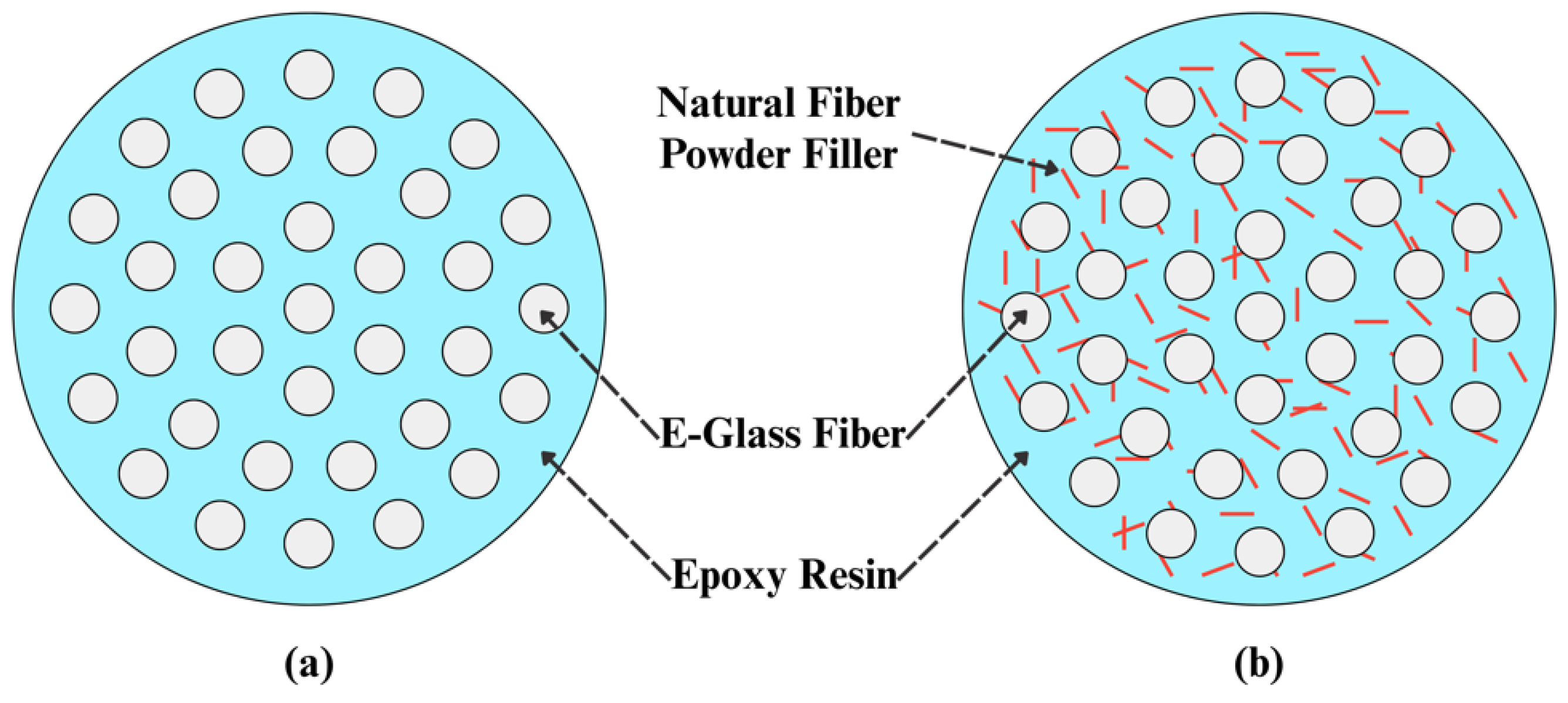


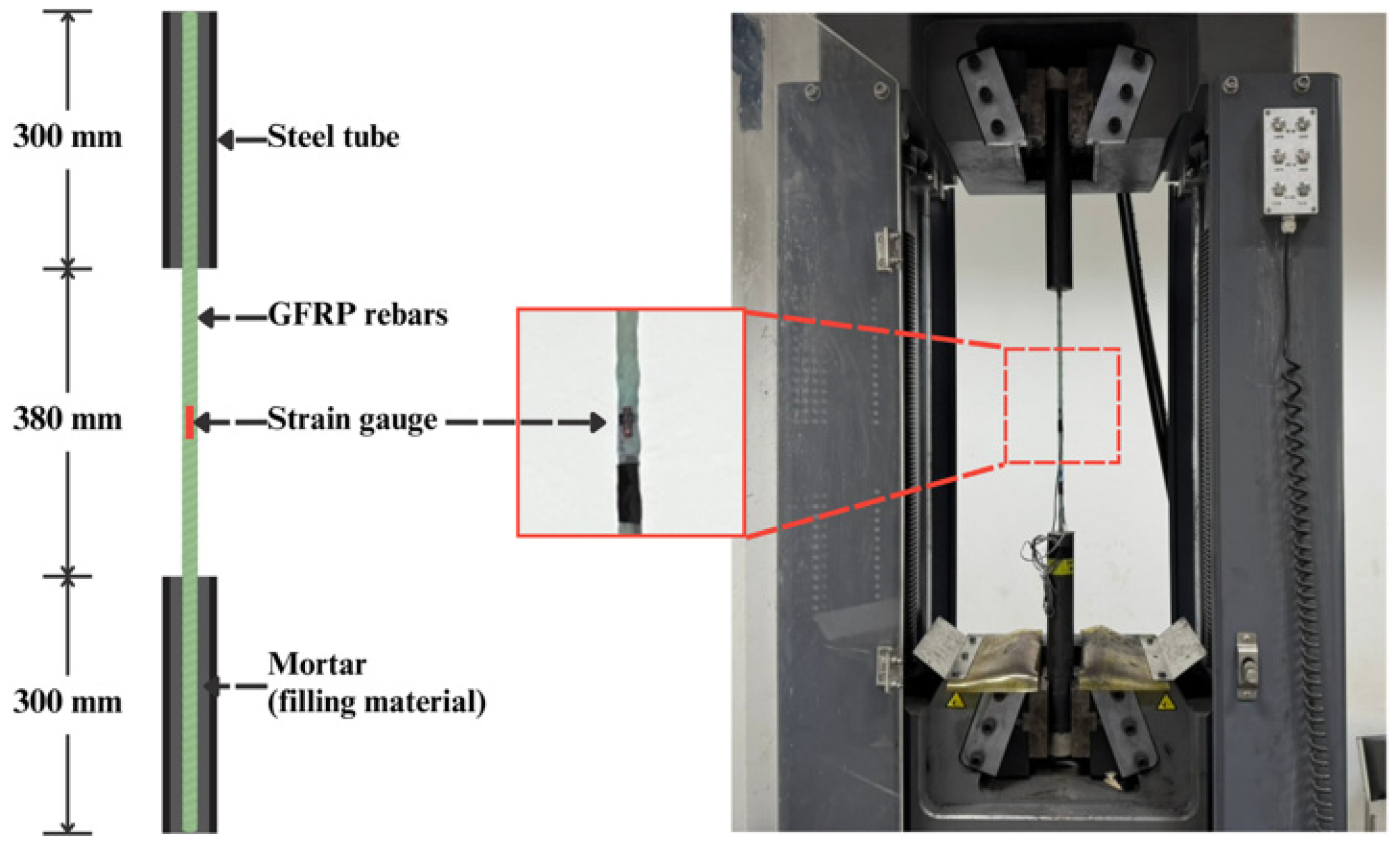
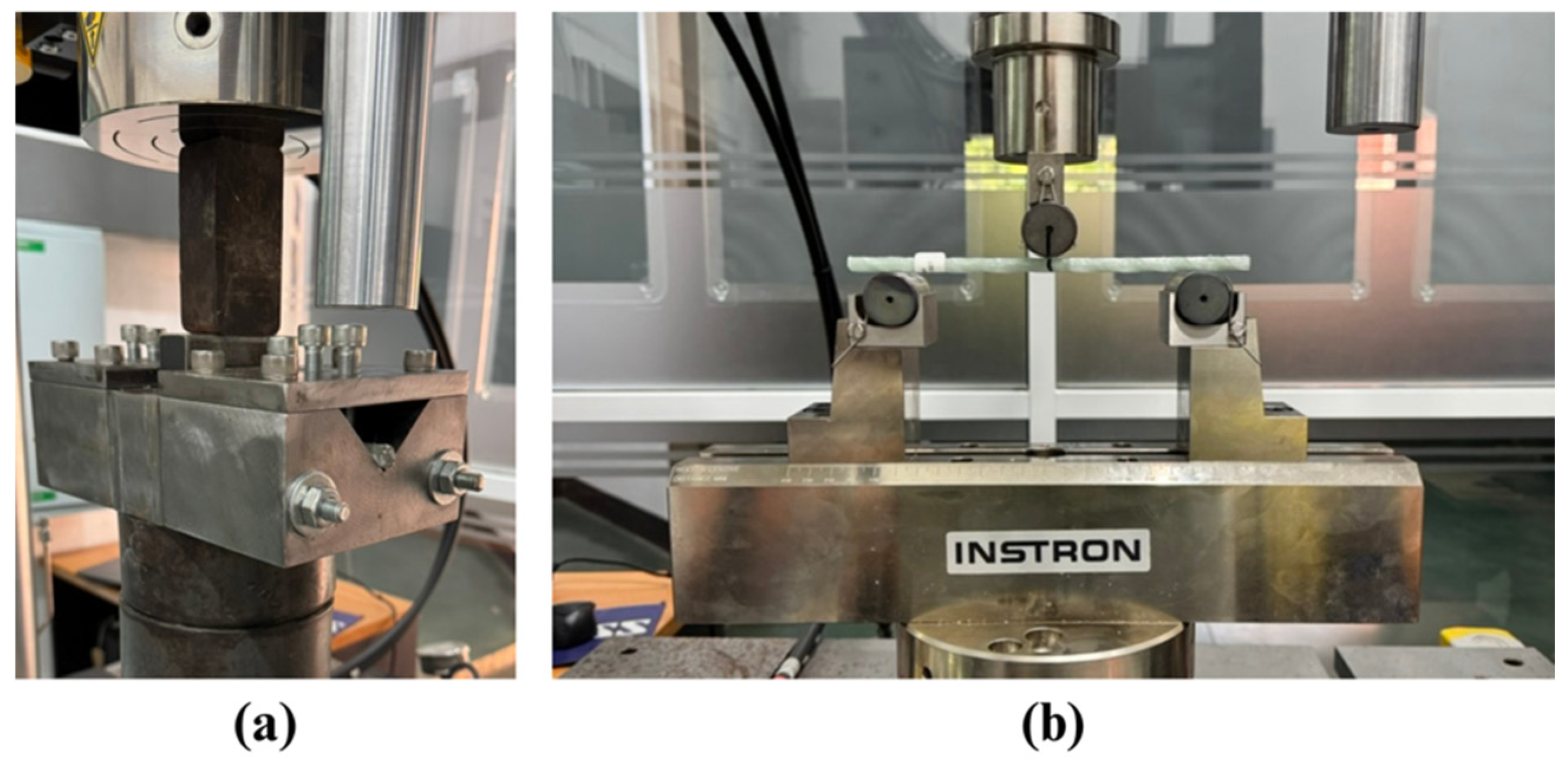

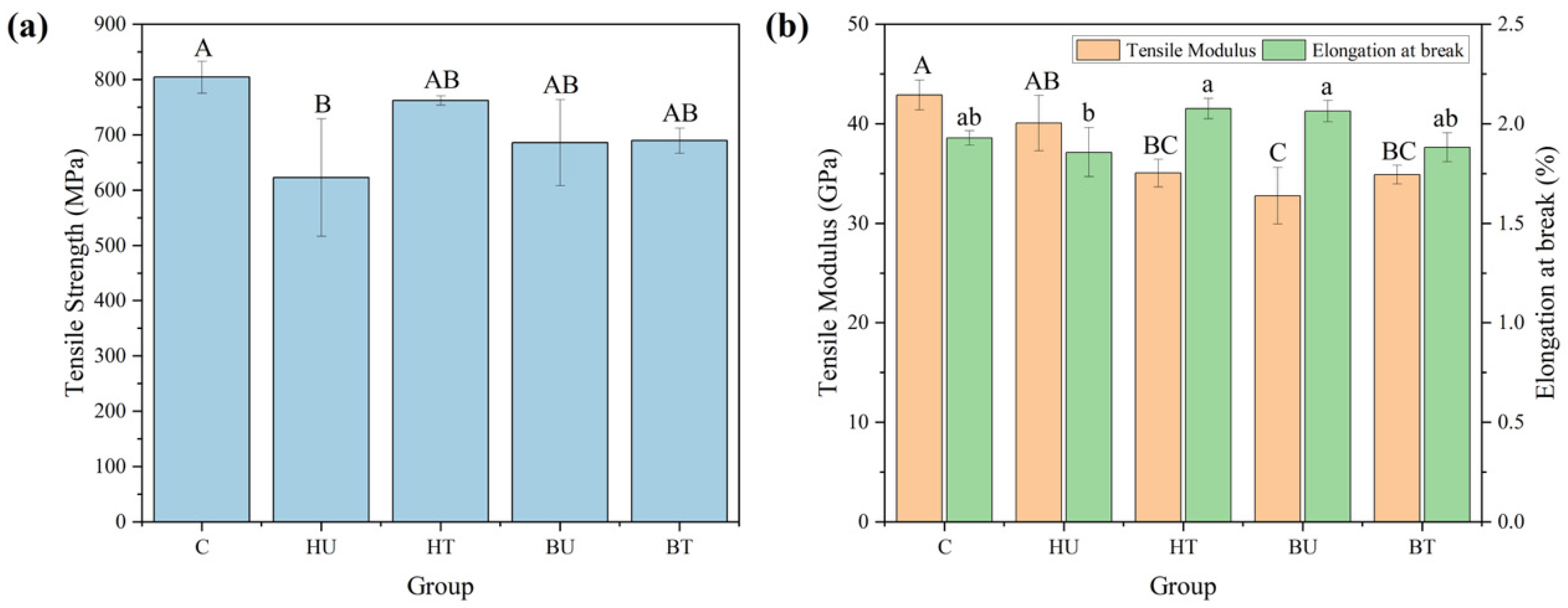
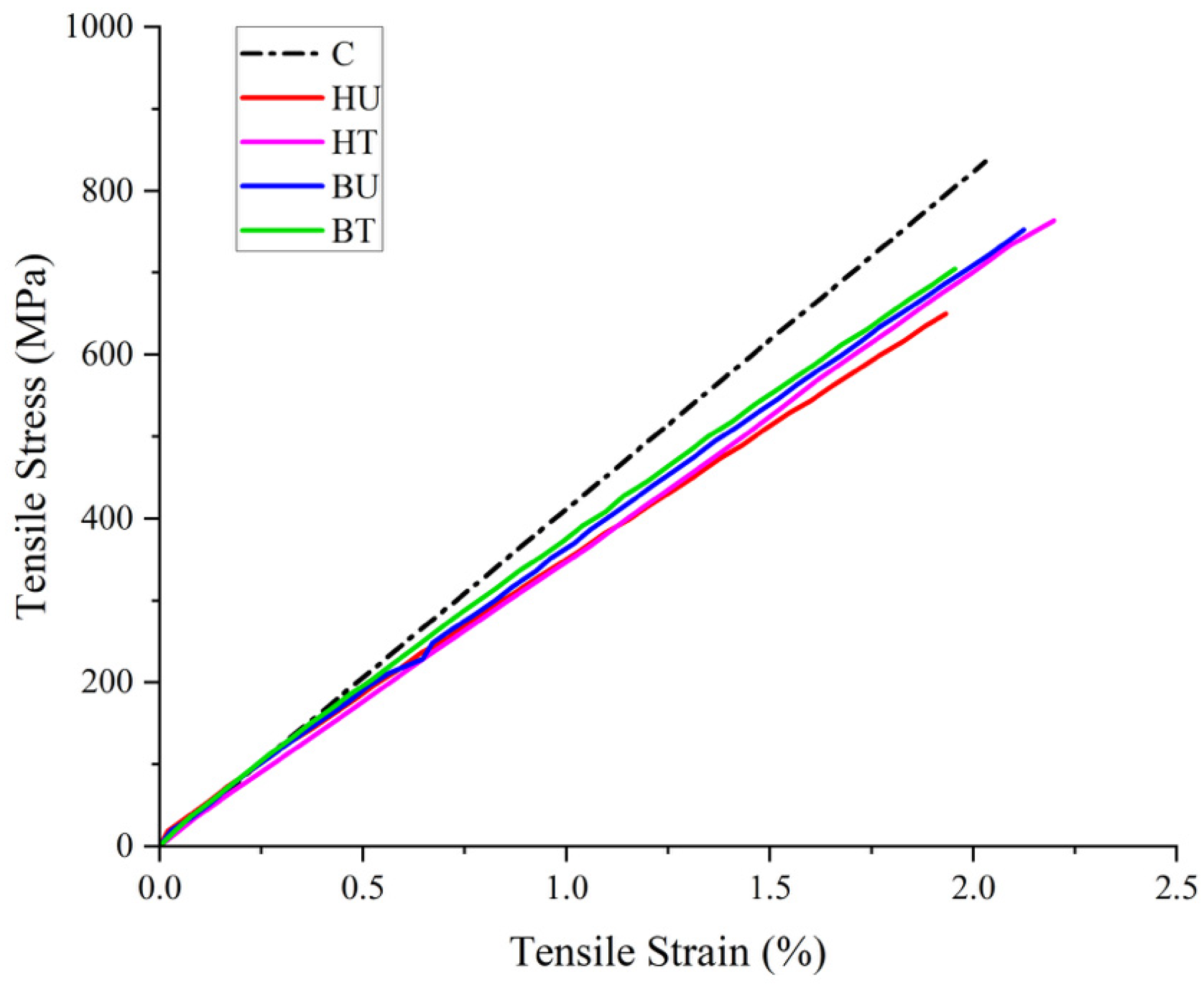
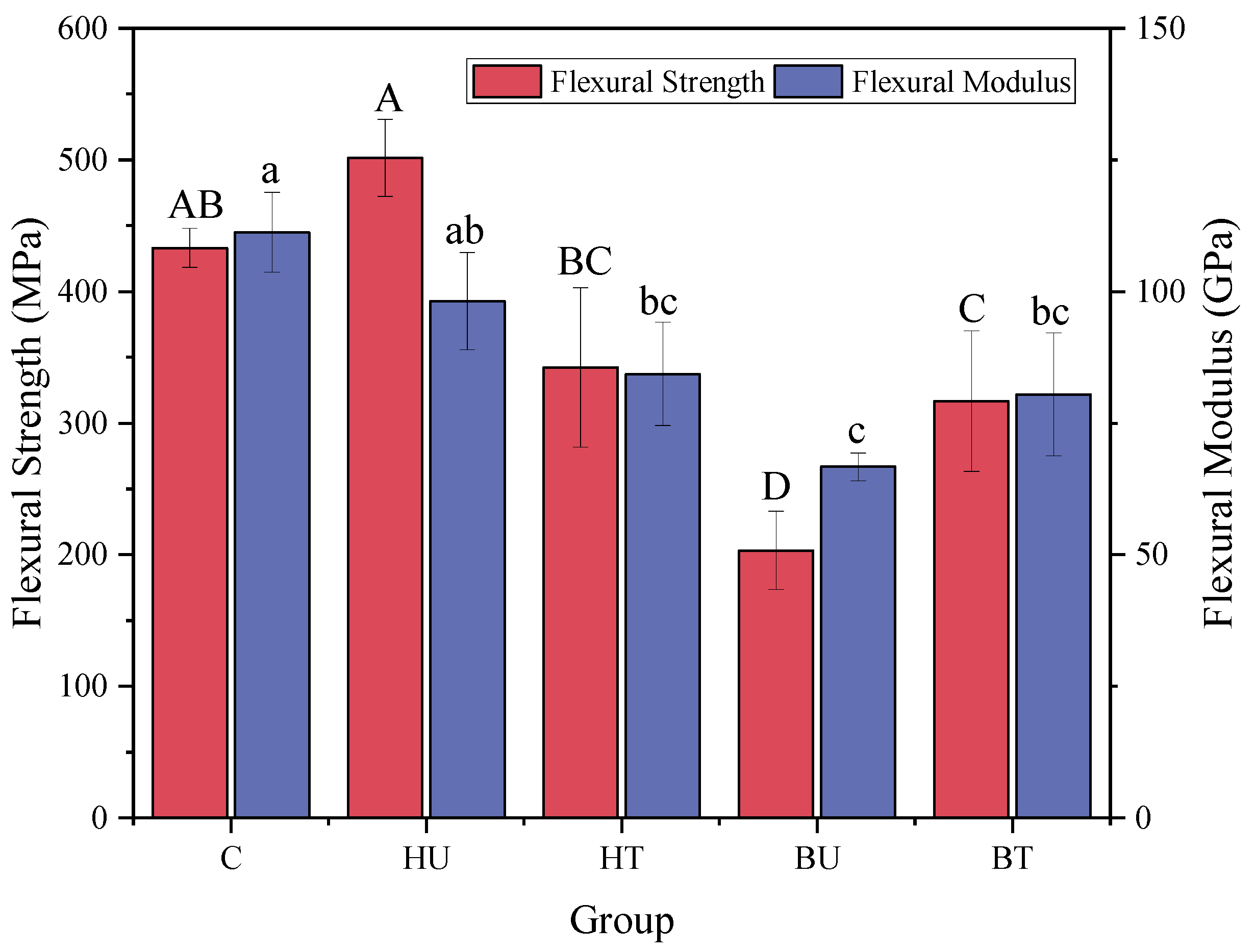

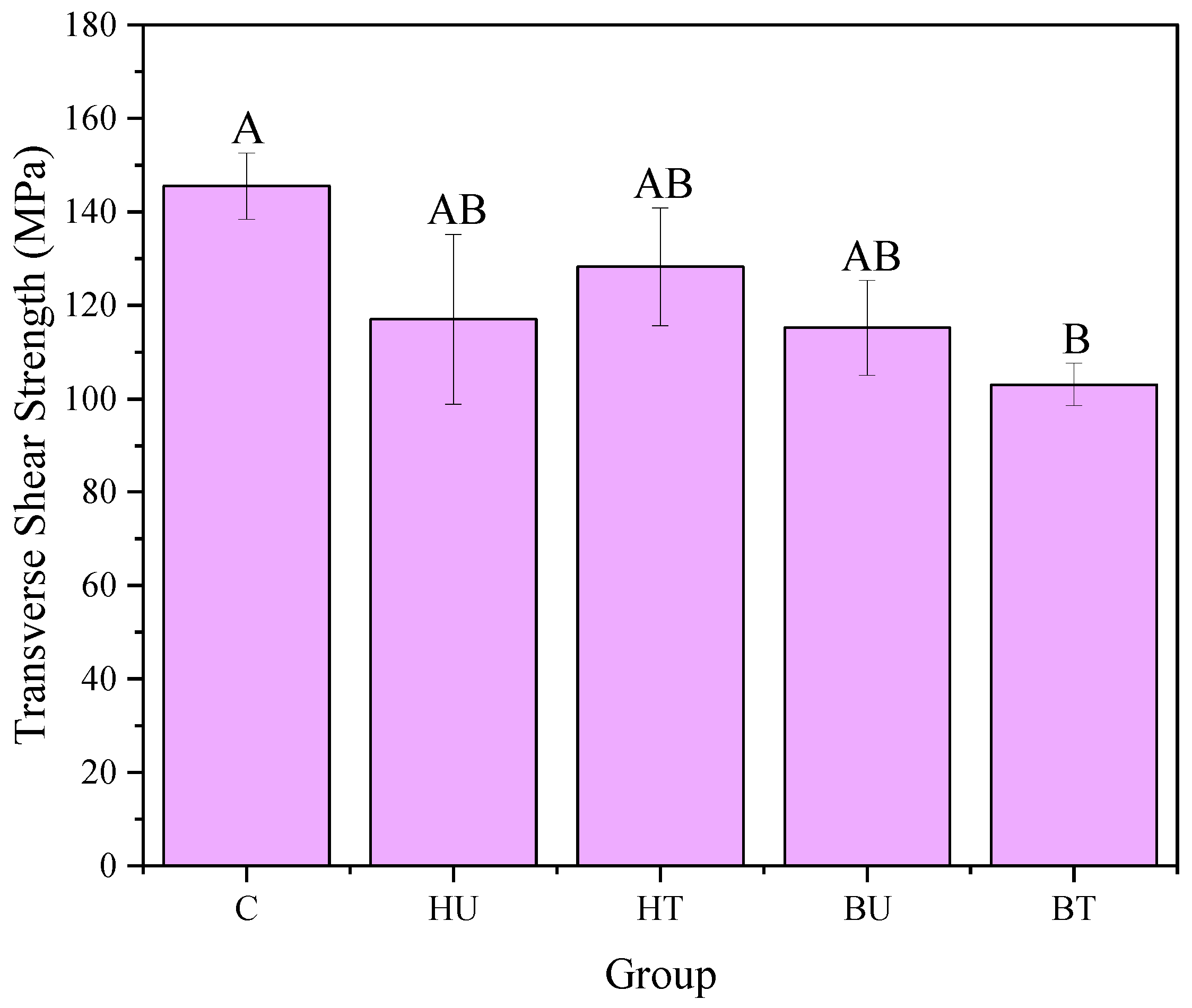
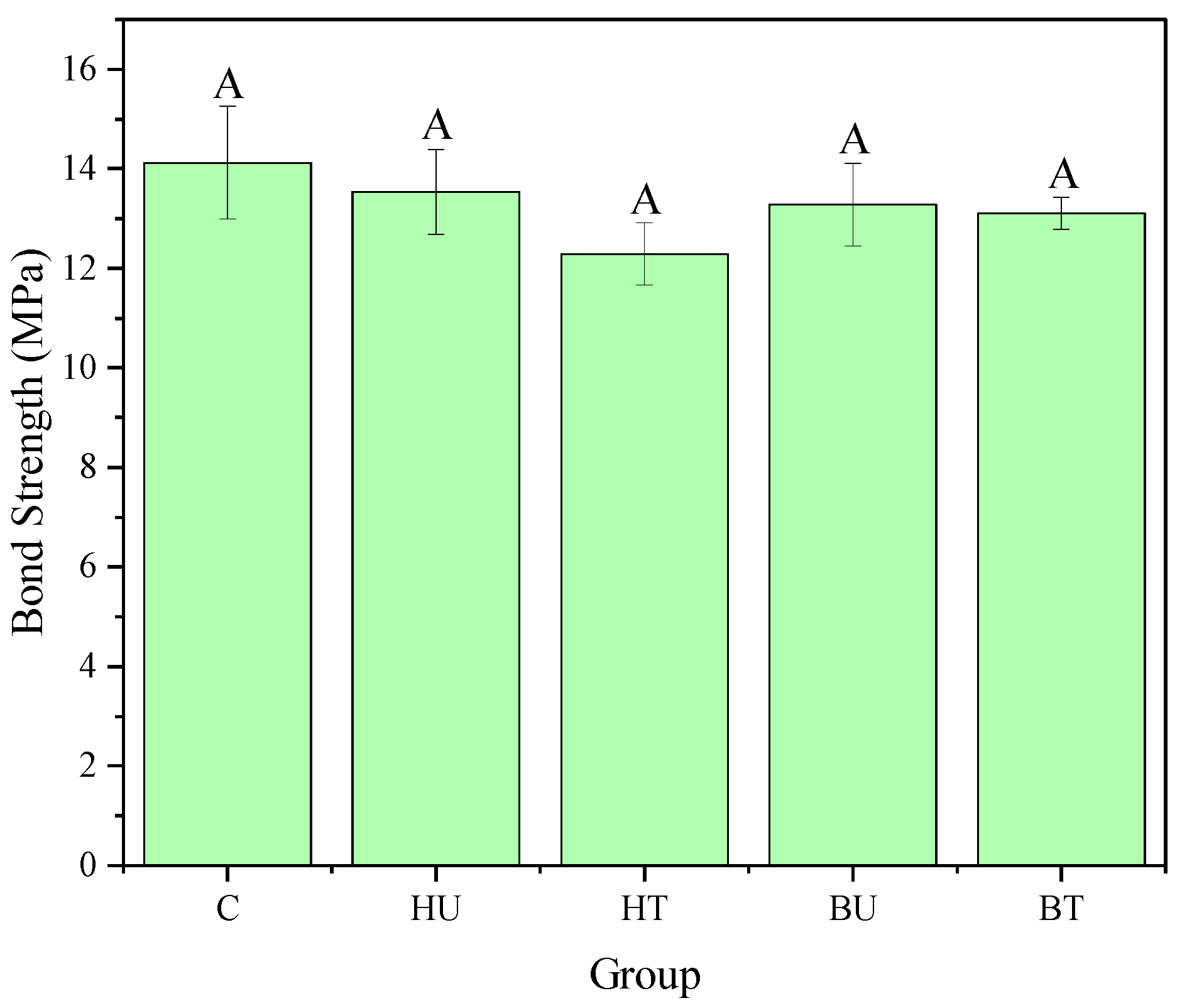
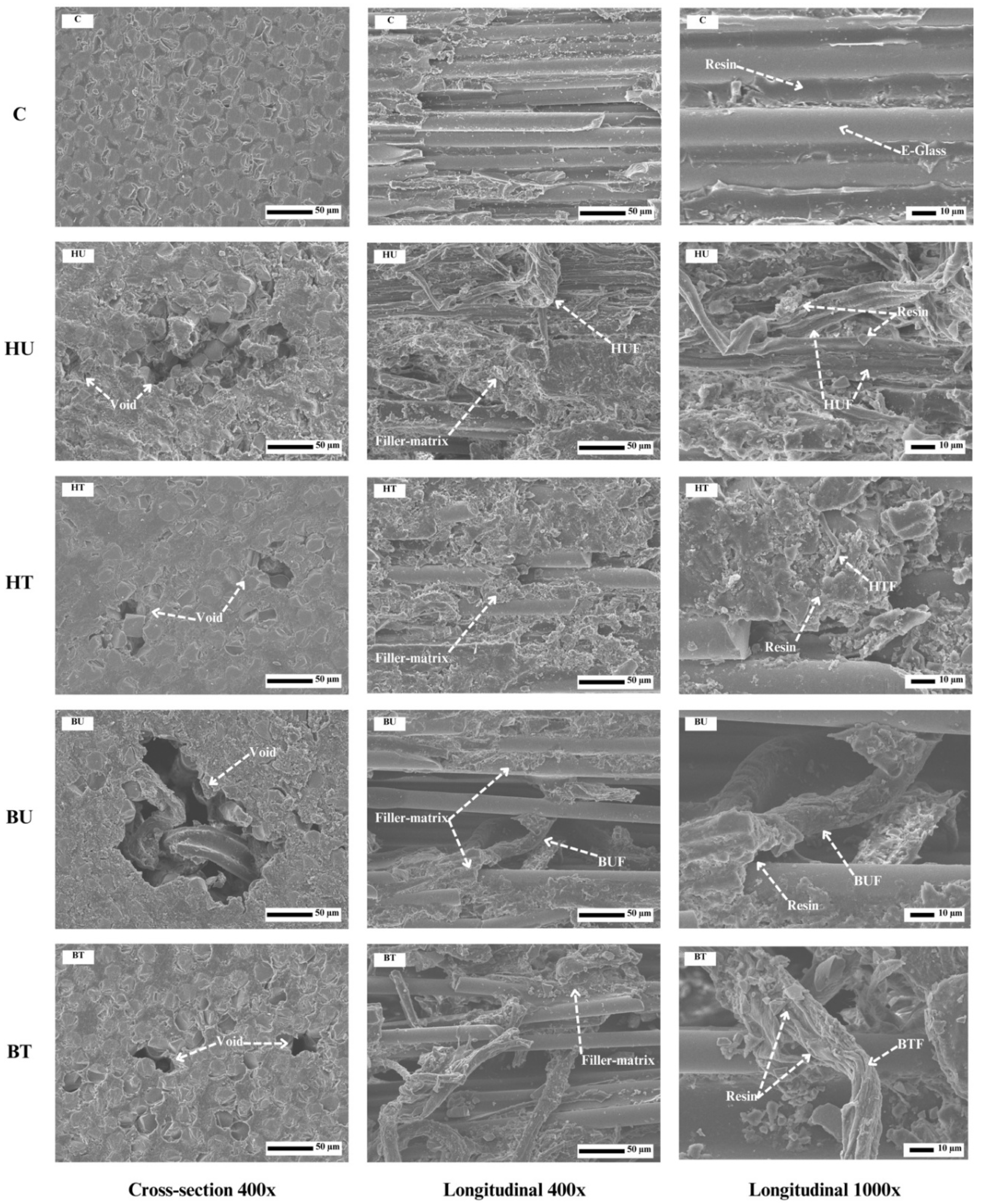
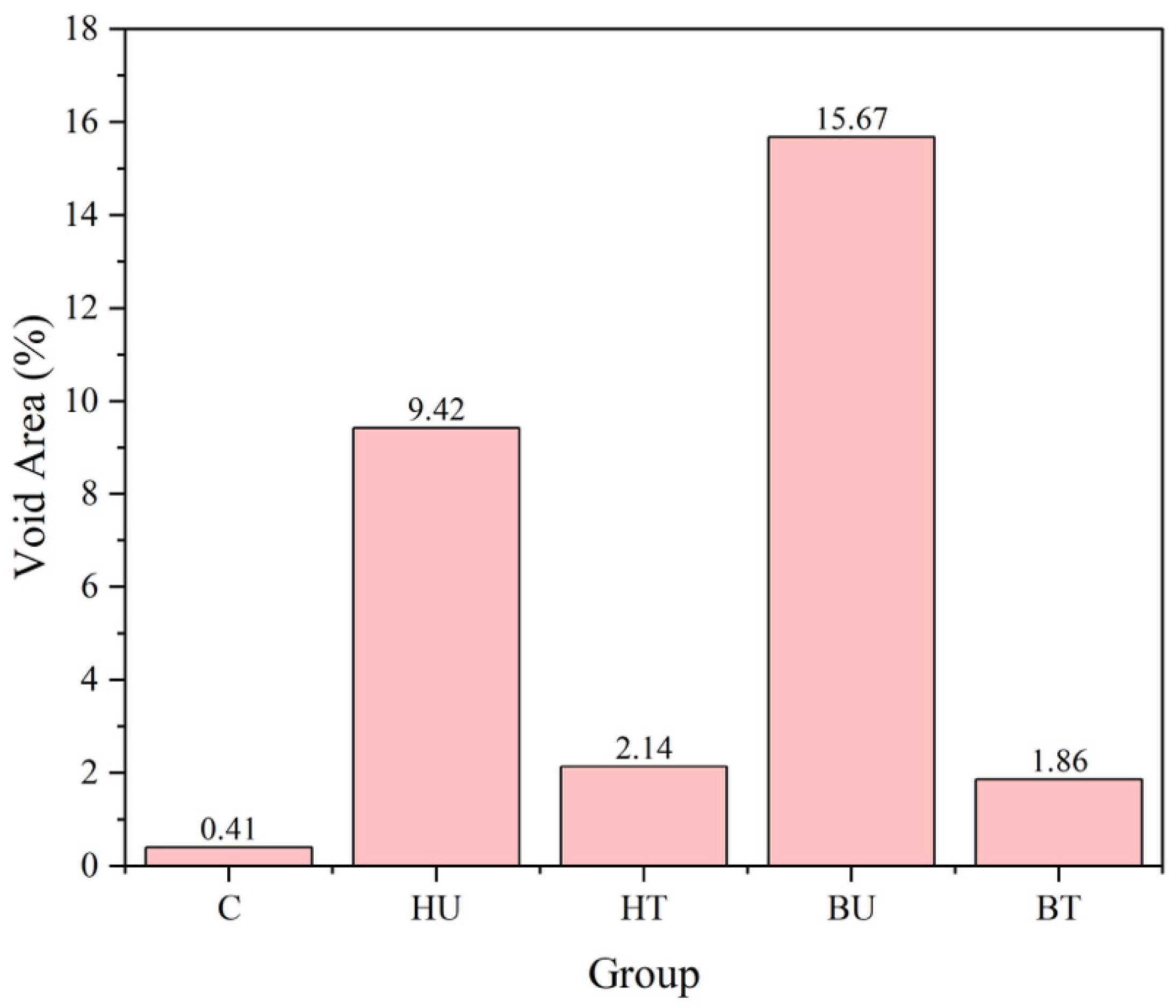

| Material | Tensile Strength (MPa) | Source |
|---|---|---|
| Epoxy Resin | 49 | Manufacturer Datasheet |
| E-glass Fiber | 2950 | Manufacturer Datasheet |
| Hemp Fiber | 200–450 | [25,26] |
| Bamboo Fiber | 275–300 | [27] |
| Group Code | Filler Type | Filler Treatment | Filler Content (wt.%) | Rebar Description |
|---|---|---|---|---|
| C | None | - | 0 | Control GFRP rebar without filler |
| HU | Hemp fiber powder | Untreated | 5 | GFRP rebar with untreated hemp filler |
| HT | Hemp fiber powder | Plasma-treated | 5 | GFRP rebar with plasma-treated hemp filler |
| BU | Bamboo fiber powder | Untreated | 5 | GFRP rebar with untreated bamboo filler |
| BT | Bamboo fiber powder | Plasma-treated | 5 | GFRP rebar with plasma-treated bamboo filler |
| Group | Tensile Strength (MPa) | Tensile Modulus (GPa) | Elongation at Break (%) |
|---|---|---|---|
| C | 804.2 ± 29 A | 42.9 ± 1.51 A | 1.9 ± 0 ab |
| HU | 623 ± 106 B | 40.07 ± 2.77 AB | 1.9 ± 0.1 b |
| HT | 762.1 ± 8.6 AB | 35.06 ± 1.39 BC | 2.1 ± 0.1 a |
| BU | 686 ± 77.7 AB | 32.77 ± 2.84 C | 2.1 ± 0.1 a |
| BT | 689.6 ± 22.7 AB | 34.9 ± 0.95 BC | 1.9 ± 0.1 ab |
| Group | Flexural Strength (MPa) | Flexural Modulus (GPa) |
|---|---|---|
| C | 433.2 ± 14.8 AB | 111.22 ± 7.54 a |
| HU | 501.5 ± 29.1 A | 98.14 ± 9.28 ab |
| HT | 342.5 ± 60.6 BC | 84.37 ± 9.82 bc |
| BU | 203.4 ± 29.9 D | 66.72 ± 2.63 c |
| BT | 316.7 ± 53.3 C | 80.44 ± 11.69 bc |
Disclaimer/Publisher’s Note: The statements, opinions and data contained in all publications are solely those of the individual author(s) and contributor(s) and not of MDPI and/or the editor(s). MDPI and/or the editor(s) disclaim responsibility for any injury to people or property resulting from any ideas, methods, instructions or products referred to in the content. |
© 2025 by the authors. Licensee MDPI, Basel, Switzerland. This article is an open access article distributed under the terms and conditions of the Creative Commons Attribution (CC BY) license (https://creativecommons.org/licenses/by/4.0/).
Share and Cite
Keereemasthong, T.; Kanthiya, T.; Kochchapong, K.; Chaiwithee, S.; Rachtanapun, P.; Jantanasakulwong, K.; Suhr, J.; Sawangrat, C.; Wattanachai, P. Enhanced Mechanical Performance of GFRP Rebars Using Plasma-Treated Natural Fiber Powder Fillers. Buildings 2025, 15, 3030. https://doi.org/10.3390/buildings15173030
Keereemasthong T, Kanthiya T, Kochchapong K, Chaiwithee S, Rachtanapun P, Jantanasakulwong K, Suhr J, Sawangrat C, Wattanachai P. Enhanced Mechanical Performance of GFRP Rebars Using Plasma-Treated Natural Fiber Powder Fillers. Buildings. 2025; 15(17):3030. https://doi.org/10.3390/buildings15173030
Chicago/Turabian StyleKeereemasthong, Thaloengsak, Thidarat Kanthiya, Kittiphat Kochchapong, Sattaya Chaiwithee, Pornchai Rachtanapun, Kittisak Jantanasakulwong, Jonghwan Suhr, Choncharoen Sawangrat, and Pitiwat Wattanachai. 2025. "Enhanced Mechanical Performance of GFRP Rebars Using Plasma-Treated Natural Fiber Powder Fillers" Buildings 15, no. 17: 3030. https://doi.org/10.3390/buildings15173030
APA StyleKeereemasthong, T., Kanthiya, T., Kochchapong, K., Chaiwithee, S., Rachtanapun, P., Jantanasakulwong, K., Suhr, J., Sawangrat, C., & Wattanachai, P. (2025). Enhanced Mechanical Performance of GFRP Rebars Using Plasma-Treated Natural Fiber Powder Fillers. Buildings, 15(17), 3030. https://doi.org/10.3390/buildings15173030









